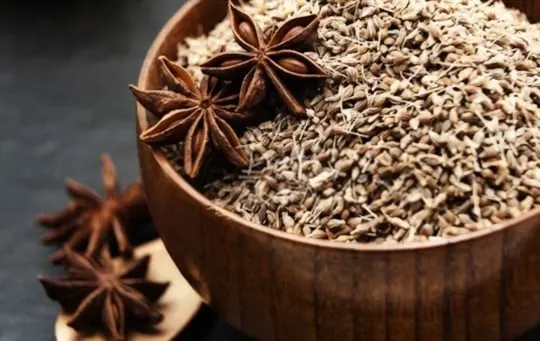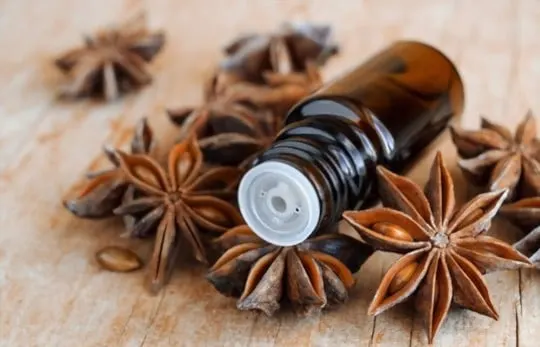In the kitchen, we all aim to be wizards, right? Bold statement: Anise Seed and Anise Extract are our magic wands.
Every cook has their preference. We love both for different reasons.
Anise Seed brings that lush, whole flavor. It’s like jazzing up your dishes with a spice that whispers sweet nothings. On the other hand, Anise Extract? It’s the convenience king. A few drops, and boom, flavor town.
Our grandmas had their take, and so do we. There’s history in these flavors, folks. Mixing them up in recipes? Always a surprise party for the palate.
Deciding isn’t simple. Each has its spotlight moment. We’ve seen it all in our kitchen experiments.

What is Anise Seed?

Anise seeds are small brown seeds that come from the plant known as Pimpinella anisum.
These seeds have a pungent, licorice-like flavor and are commonly used in culinary preparations.
Anise seeds boast various health benefits, including aiding digestion, reducing bloating, and soothing symptoms of cough and cold.
They can also be used to make herbal teas and flavored syrups for desserts.
What is Anise Extract?

Anise Extract is a flavor enhancer that is derived from anise seeds.
It can be purchased in liquid or powder form and is commonly used to add a sweet licorice taste to various dishes and beverages.
Unlike Anise Seed, which must be ground or crushed before use, Anise Extract can be quickly and easily added to recipes.
Moreover, it provides a more concentrated flavor compared to Anise Seeds, making it an excellent choice for adding flavor to baked goods such as cakes, cookies, and bread.
Additionally, it is also used in the production of liqueurs like ouzo and absinthe due to its unique sweet and slightly spicy flavor profile.
Differences Between Anise Seed and Anise Extract

Anise Seeds and Anise Extract are two different forms of anise.
Both are used in various cuisines but have differences in their properties, usage, and storage.
Anise Seed is the whole seed of anise that has a strong flavor and aroma.
On the other hand, Anise Extract is a concentrated form that is obtained by adding alcohol to anise seeds and then distilling it.
It has a more intense flavor than Anise Seed.
When it comes to using these two forms of anise, Anise Seed is mostly used for garnishing dishes or adding texture to baked goods.
Whereas, Anise Extract is used for giving flavor to recipes like cakes, cookies, and beverages.
Also, since Anise Seeds have a longer shelf life than Anise Extracts due to its low moisture content, they can be stored for a more extended period.
Apart from the above-stated differences between Anise Seeds and Anise Extracts, one must also note that excessive usage of either can hamper the flavor profile of the dish being prepared.
Additionally, some individuals may develop allergic reactions to either form, so caution must be exercised before consumption.
Source and Form
Anise seed and anise extract are two significant forms of anise that have unique uses and benefits.
Anise seeds come from the anise plant, whereas anise extract is derived from steam distilling dried anise seeds.
Both sources have their own distinctive fragrance, taste, and potency levels.
In terms of form, the whole anise seed offers a more robust flavor than its extract counterpart.
Additionally, seeds can be crushed or ground to release their oils, while extracts are already in liquid form.
Therefore, for those seeking a stronger flavor or who prefer using fresh or dried herbs in cooking and baking, anise seeds are the better option.
However, if ease of use is more important or specific measurements are required for a recipe, then the diluted and measured form of extract can be preferred.
Flavor Profile and Intensity
Anise has a distinct and intense flavor profile with hints of licorice and fennel, making it a popular ingredient in many culinary traditions.
The intensity of the flavor varies between anise seed and extract, with anise extract being more potent.
In terms of flavor profile, anise extract has a stronger licorice taste, while anise seed has a stronger fennel note.
It ultimately depends on personal preference and the recipe requirements to determine whether to use anise seed or extract.
Both options can add depth and complexity to dishes such as baked goods, liqueurs, and savory sauces.
Usage and Application
When it comes to using anise in culinary preparations or as an herbal remedy, it is important to understand the different options available – anise seed and anise extract.
Anise seed is commonly used as a spice in baked goods, liqueurs, and teas; whereas anise extract is a concentrated liquid made from the essential oils of the seeds.
While both options can provide a similar flavor profile and aroma, their application can vary significantly.
Anise seed is typically used in whole or ground form and requires additional preparation before use in recipes.
On the other hand, anise extract offers a more convenient option for incorporating this unique flavor into dishes.
It can be added directly to liquid-based recipes like drinks, syrups, or icings.
A key consideration when deciding between anise seed and extract may be potency – as extracts are often much more concentrated than raw seeds.
This means that a smaller amount of extract may be needed to achieve the same level of flavor as larger proportions of whole or ground seed.
In summary, whether you choose to use anise seed or extract ultimately depends on your desired application – convenience, shelf-life, potency requirements etc.
Both options bring unique nuances to recipes or herbal remedies alike but should be chosen based on individual needs.
Similarities Between Anise Seed and Anise Extract

Anise seed and anise extract share some similarities in terms of flavor and usage.
Both have a sweet licorice-like taste and are commonly used in baked goods, sweets, and beverages.
They also have medicinal properties and can aid in digestion, relieve coughs, and ease menstrual cramps.
However, anise extract is a concentrated liquid form extracted from the seeds while anise seed is the whole seed itself.
When it comes to cooking or baking, the two can be used interchangeably but with different measurements since the extract is more potent than the whole seeds.
Anise extract is easier to use since one only needs to add a few drops to the recipe while using anise seed requires grinding or crushing before use.
Overall, both anise seed and extract offer similar flavors and medicinal properties but differ in their form of delivery for culinary purposes.
It all comes down to personal preference and convenience when choosing between the two options.
Culinary Uses of Anise Seed and Anise Extract
Anise seed and anise extract are two popular ingredients used in a wide variety of dishes.
Anise seed is often used as a spice in baked goods, while anise extract is commonly used as a flavoring agent in drinks and sweets.
The distinct licorice-like taste of both these ingredients makes them a favorite among people who enjoy sweet treats.
When it comes to culinary uses, anise seed and anise extract each have their unique benefits.
Anise seed is more versatile, providing not only flavor but also texture in foods like bread and cookies.
On the other hand, anise extract has a more concentrated flavor, making it ideal for use in recipes where you want a stronger licorice taste without consuming too much food.
Whether you choose to use anise seed or extract largely depends on your personal preferences and the recipe you’re making.
Both options bring their own unique flavor profile to any dish or drink they’re added to, creating an enjoyable culinary experience for those who love licorice flavor.
In addition to its use in baking and cooking applications, anise has been linked with several health benefits, including aiding digestion, reducing inflammation and improving brain function.
Its widespread use throughout history shows its versatility beyond culinary uses and highlights its value as both a versatile ingredient and natural remedy for various ailments.
How to Substitute Anise Seed for Anise Extract and Vice Versa?
Found in various recipes for baked goods and more, Anise seed and extract are similar ingredients that can be substituted for each other in many cases.
Below is a guide on how to use one in place of the other.
- Begin by calculating how much anise extract or seed is called for in the recipe. Use this amount as a reference to determine how much of the other ingredient will need to be added.
- For anise seed, use a spice grinder or mortar and pestle to prepare it. Once grinded into a fine powder, add it directly to the recipe as needed.
- Alternatively, if using Anise extract, dilute it with water at a ratio slightly below 1:1. Then pour “an equivalent amount” from the mixture into your recipe’s mix.
- Properly store any leftover anise seeds or extract by placing them in labeled plastic bags or containers with tight-fitting lids. Keep them in a cool, dry location away from strong smells so they can last longer.
When substituting Anise seed for Anise Extract or vice versa, there aren’t many variations you can incorporate as both are distinct ingredients that serve almost the same purpose.
However, experimenting with different recipes may still lead to a unique flavor profile worth exploring further.
Conclusion
Comparing anise seed and anise extract can give you a better idea of which option is best for your needs.
Both options have their unique advantages.
Anise seeds are great for adding flavor to baked goods and other dishes, while anise extract is more potent and concentrated, making it an ideal choice when flavor intensity is a priority.
It ultimately comes down to what you want out of your dish.
Consider the recipe’s requirements, the amount of flavor needed, and how strong you want the anise taste to be.
Experimentation will help you find what works best for you.

Leave a comment